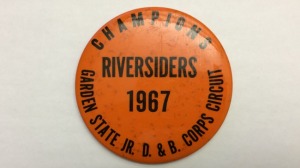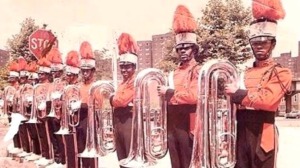W’EN de colo’ed ban’ comes ma’chin’ down de street,
Don’t you people stan’ daih starin’; lif’ yo’ feet!
Ain’t dey playin’? Hip, hooray!
Stir yo’ stumps an’ cleah de way,
Fu’ de music dat dey mekin’ can’t be beat.
Paul Lawrence Dunbar
Paul Lawrence Dunbar published The Colored Band in 1913. In its time this poem was a remarkable depiction of the power of black music in motion. Dunbar was among the first African American poets to gain international prominence, bringing attention to the higher spirit of African American life in its raw unfiltered form. It was before the civil rights movement, which would come 50 years later and well before competitive Drum Corps was organized.
In the mid-1960’s nestled between the Fort Greene and Farragut housing projects of Brooklyn, a musical spark was lit when a talented and brilliant musician and organizer named Billy Borden sought to create a competitive drum and bugle corps from a rag-tag group of project kids who were impressed by a black corps out of Bedford Stuyvesant called The Privateers. Borden was a drummer and color guardsman in The Privateers, but though pressures of time and circumstances The Privateers became defunct, but not Borden’s dream to build upon his vision.
At the time, there were plenty of black marching bands, mostly church and boy scout units that would strut their stuff on Brooklyn Day in June, a local holiday founded to commemorate the establishment of Sunday School in the borough. But few were at the level of the Privateers, which inspired just about every local kid with a pair of drumsticks and the ambition to blow a horn.
As the civil rights movement raged around us, little attention was paid to the sense of pride and accomplishment of these bands as they serenaded the urban landscape. The Riversiders practiced in a quarter mile square patch of grass we called “City Park” which separated the Fort Greene and Farragut projects near the Brooklyn Navy Yard. From late spring to mid summer nights you would hear us go though our repertoire as we learned our drill maneuvers.
The Riversiders can be seen at 3:57 in this video provided by YouTube channel CWOWMS
This beautiful black fraternity bonded by music and camaraderie was all-inclusive. We were adolescents, teens, males, females and young adults providing a vocal and visual demonstration that project life could produce something very special. Sit-ins were ongoing at southern lunch counters, black students were being hosed and attacked by dogs. Governors were barring the door denying black students entry to universities and we were giving hope to everyone who could hear us that our unity through music would deliver us from the ghetto.

The button worn by our parents with pride following winning the Garden State Circuit Championship in 1967
I remember coming home from practice many a night being greeted by my mom, a single parent, saying “Son, I heard your music echoing off the project walls and I am so proud of you. She was proud even more when a few years later The Riversiders won the Garden State Circuit Championship that was sanctioned by Drum Corps International (DCI), an accomplishment that lifted us against white units that were better financed, orchestrated and coached. For many a black kid those days, we were impacted by poverty, a pervasive war in Vietnam with many of us not going to college and being drafted right out of high school and the trap of heroin addiction. Drum corps was a way out, a way to travel and a way to build enduring friendships though healthy sharing and competition. The pride we took in our accomplishments had a halo affect on our neighborhoods and those neighborhoods were often known for their drum corps. The skill and the art of music were disciplines that kept a lot of us hopeful and on a positive path.
When you are a teenager, it is hard to fathom that what you represented was iconic to the times. Black people making strides, moving forward in a tumultuous world set in motion by Malcolm X, Martin Luther King, Stokely Carmichael and Fred Hampton among others. Pride of accomplishment was nestled in the eyes of our parents and neighbors as we sat on the benches in a park under the Brooklyn Queens Expressway we dubbed “The Shady Rest,” practicing our music and socializing in ways that built character and skills that would stay with us thorough adulthood.

This is a shot of the horn section of The Riversiders Jr. Drum and Bugle Corps of Brooklyn NY, circa 1966-67. I was known as “Garfield” and played baritone bugle. I am fifth from the right.
The guttural and antiquated descriptions expressed in the 1900’s depiction of Lawrence Dunbar’s ‘The Colored Band” gave way to the cry of “Power to the people” eloquently expressed in the competitive success of Black Drum and Bugle Corps of the ‘60’s. This is something I carry with me in my professional life and pass on to my child and to my peers.
You can follow Will J. Wright on Twitter: @willjwright
Additional information regarding The Riversiders Jr. Drum and Bugle Corps:
THE RIVERSIDERS 1965-1968
STAFF-Dir.: Mr. James Watkins,
Ctr. Cord.: Sis. Mary Terrence, Dr. White Community Center 200 Gold Street, Brooklyn, NY
Asst. Dir.: George Brown ( ex: Privateers)
Horn line: “Baby John” Chalmus (ex: Privateers & Blessed Sac)
M&M & Color Guard: Billy Borden (ex:Privateers)
Drumline: Bobby Winslow (simultaneously taught Minisink CMCC Warriors)
UNIFORMS: Orange west-point style cadet jackets, black pants (orange stripe) and white pearl shakos, resurrected from the disbanded Laredo Knights of Brooklyn NY, Catholic Youth Organization and American Legion
REPRETOIRE: Laredo/ Battle Hymn–Johnnie Comes Marching Home (Jazz-swing) The Robe, Mission Impossible/ Wade In The Water (jazz-swing)/ You Only Live Twice
HISTORY: Competed in the Garden State & NY Circuits. The horn line of was powerful with crisp screaming sopranos, a rich mellophone/french section and a lush bottom baritone and concho horn line, that created tapestries of sound. The drumline’s clean snares, bopping tenor line and assorted base/cymbal sections were the prototype for much of the DCI drumming today. The Guard was snap incorporated with a rifle and saber line that twirled around their necks and every other way possible. Their Marching and maneuvering was clean and geometrical but had the swagger to match their musical swing.
They made a mighty rise to take the Garden State Championship in 1968 but disbanded at the season’s end.
At least 1/3 of the corps joined the Minisink (CMCC) Warriors. With 1/3 of the disbanded Carter Cadets also joining Minisink, that combination created the 1969 juggernaut Warrior machine, The “Black Attack” with Hy Dreiser’s most magnificent Gershwin season.
(Historic background written by Carl Cherebin, 2nd baritone. 3/3/10)
Hey’ Mr. W. Wright ..Good show I remember the River siders ,my sister Pat Peterson was a part of the drum and bugle corps. well keep up the good work .maybe we can get together some day and bring about a new Riversiders ..Hope to hear from u soon..Mark
LikeLiked by 1 person
My family the Locklear’s were an integral part of the Riversiders, however I do not think they disbanded in 1968
LikeLiked by 1 person
Hi Melissa. The 1st. Riversiders Corps. disbanded after the ’68 championship (maybe ’69).
Their feeder corps, The Streamliners became the new (2nd) Riversiders corps into the 70s.
Frank played 1st Baritone, Ronnie was played snare drum (& Drum Major one season) and Sheila was in the Guard, on Flags.
They very talented and brought a lot of strength to the corps.
The blogger only used the history of the 1st corps but excluded
the history of the 2nd corps & 3rd corps.
Best.
Carl Cherebin
2nd Riversiders
LikeLiked by 1 person
Hey Carl! Thanks for filling in the post-script to the story I wrote about my Riversider’s experience. It is good to know the legacy lived on. For those of us who were part of The Riversiders, be it R1, R2 or beyond, the experience was an important source of personal achievement, neighborhood support and family pride!
LikeLike
The 1st Riversiders corps disbanded after the ’68 championship.
Their feeder corps, The Streamliners became the 2nd Riversiders from 69-72.
Frank 1st Baritone (& Quarter-Master), Ronnie snare line (& Drum Major for one season) and Sheila in the Guard, on flags, brought power and excellence to their sections. The blogger excluded the history of the 2nd and 3rd corps.
Carl Cherebin
2nd Riversiders ’69-’71.
LikeLike
My uncle is 4th from the right in the main pic
LikeLiked by 1 person
Go to corpsreps.com for the full history of the Riversiders (3 corps)
LikeLiked by 1 person